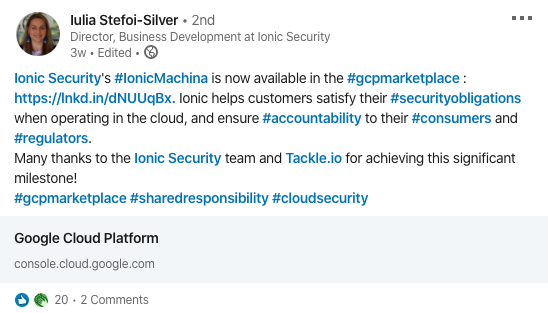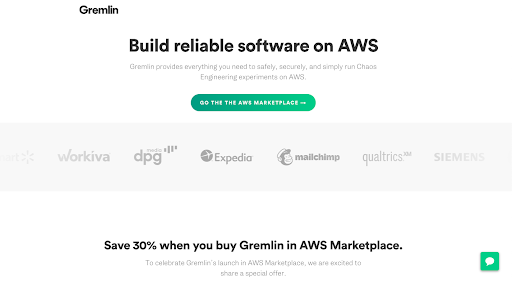One of the perks of selling your software on Cloud Marketplaces is that you introduce your software to a new audience. On top of empowering your sales team to bring current customers to the Marketplace, you’ll want to bring new organic traffic to your listing.
Having a launch plan on what levers you’ll pull to drive Marketplace traffic is crucial. After all, “build it, and they will come” isn’t a strategy you can take to the bank.
Here’s what you need to know about generating attention for your Marketplace listing.
5 Stages of Generating Organic Marketplace Interest
Your Marketplace launch strategy is too big a beast to tackle in one go, so we advise splitting your planning and execution into five steps.
Announce availability to your network
You should use your first days and weeks on a Cloud Marketplace to spread the news of your new sales channel far and wide. Here are a few of the tactics that Tackle customers have successfully used to announce their Marketplace debut.
Write a press release
A press release is a great way to consolidate information about your launch and share it with your network and the media. For example, Talend Cloud announced its availability in Microsoft’s Azure Marketplace and the release included quotes from the Talend Cloud and Microsoft team. CloudBees announced availability on AWS Marketplace and added some additional information to their announcement with a landing page and datasheet.
Plan social media promotion
Social media promo doesn’t have to be complex to be effective. Simply having your executives and sales team share posts about the launch on their customer-facing social channels, such as LinkedIn, is a great place to start.
Iulia Stefoi-Silver, Director of Business Development at Ionic Security, leveraged her LinkedIn network to share that Ionic’s product was available on the Google Cloud Platform Marketplace. The post lets her followers know what is available on which network and whom the product can help.
Launch a dedicated Marketplace landing page
Having a dedicated place to direct interest is crucial. Your website homepage should mention your new sales channel, and a dedicated landing page educates potential customers with additional details.
Here’s a great example of Gremlin creating an AWS Marketplace-specific landing page to highlight some well-known customers and offer a Marketplace launch discount.
Run paid ads to your dedicated landing page
Consider using paid ads if you want to boost initial traffic to your launch site or Marketplace listing. While technically this isn’t an organic tactic, it can help you build interest. To decide whether to direct traffic to your landing page or Marketplace listing, consider who you’re targeting and how much they know about you and Marketplace availability.
Create a launch video
59% of executives would rather watch a video than read a written post on LinkedIn, so a video can help you quickly grab their attention.
To create a launch video, think of the few most important details. For most companies, this would be which Marketplace you’re available on, insights into the benefits of buying via the Marketplace, any introductory offers or pricing changes, and where to look next. Here’s a great example from A Cloud Guru of how they did this to announce their AWS Marketplace launch.
Go ahead and use these video posts to drive traffic to your landing page or Marketplace listing.
Tell your audience
Your database is already filled with customers and prospects, which means they’re the perfect audience to hear your Marketplace news. Create an email that covers the same essential details as your other promotional channels, and drive traffic back to your landing page or listing.
Think about ways to make the emails standout: maybe it’s more personalized and comes from your CEO or CRO, or perhaps you include a funny GIF to make it memorable. Be creative!
Use free trial traffic to get people into a Marketplace pipeline
A simple tweak could drive Marketplace adoption if your product lends itself to organic discovery and adoption via free trials. Microsoft has found that 1 in 4 Marketplace searches are filtered on offers that include a trial.
Some Tackle customers, such as GitHub, have leveraged existing free trial marketing strategies to drive prospects on their website to sign up, and then finalize the deal on Marketplace. By keeping your already successful systems in place and merely swapping where the final transaction takes place, you can drive Marketplace traffic using work you’ve already done.
Educate your sellers and partners about your success
Your sales team is on the front lines of driving Marketplace success day in and day out, so they need thorough education about the tools at their disposal. This includes teaching the sales team about how and when to introduce Marketplaces into conversation with prospects.
As you complete a few transactions via the Marketplace, it’s time to start building case studies. However, your initial success stories shouldn’t focus on your customers.
While it may seem counterintuitive to put customer case studies on the back burner, you need to first educate and empower your sellers and partners. To start, create case studies that let your sales team see how the process worked for fellow sellers.
Then, move into spotlighting how your company is valuable to Marketplace partners. How is your company driving business within the Marketplace, and what are the benefits of working together?
Once you’ve knocked down the dominoes of getting buy-in from your sales team and your Cloud Provider partner, you can move on to marketing how the Marketplace benefits your prospects.
Leverage Cloud Provider programs
Another way to drive more traffic to your Marketplace listing is to leverage programs from the Cloud Providers. While the details vary between Marketplaces, each Cloud Provider offers unique GTM and demand generation programs that can help get your listing more exposure.
For example, Microsoft’s Partner Network has a “Marketplace Rewards” program that offers cascading tiers of benefits designed to support sellers at different stages of the Marketplace journey. Those looking to accelerate time-to-market and generate demand can take advantage of competencies such as business profile optimization and referral management, co-branded marketing assets, the ability to create a partner success story, press release and editorial reviews, etc.
Make it a C-suite conversation
The final component of your plan to drive organic traffic to your Marketplace listing is to utilize executive buy-in. As the face of your company, in public-facing channels such as earnings reports, your CEO can drive much-needed attention to your Marketplace partnerships.
For example, Ping Identity mentioned its new AWS Marketplace availability in their quarterly public report. Crowdstrike also talked about their success with selling via the Marketplace on their earnings call. George Kurtz, the CEO of Crowdstrike, said, “We’ve got a great partnership with AWS. It cuts the sales cycle down when we use the AWS marketplace by almost 50%.”
Even without your CEO publicly praising Marketplaces, having executive buy-in can accelerate success. After all, it’s much easier to implement a tactic if it’s ingrained in company strategy from top to bottom. Since topics such as deal velocity and guaranteed collection are often top-of-mind in the C-Suite, there’s a natural opportunity to bring Marketplace conversations to leadership.
Any new sales or marketing venture can feel like a daunting mountain, but all it takes to climb is a step at a time. By splitting your traffic-generating strategies into stages, you can more easily manage your to-do list. Plus, your existing resources such as free trial traffic, social networks, and email lists can help you get a needed push out of the gates.
Once you’re ready to take this new sales channel to the next level, check out our guide on how to Scale Your Revenue Using Tackle’s Private Offer Acceleration.




